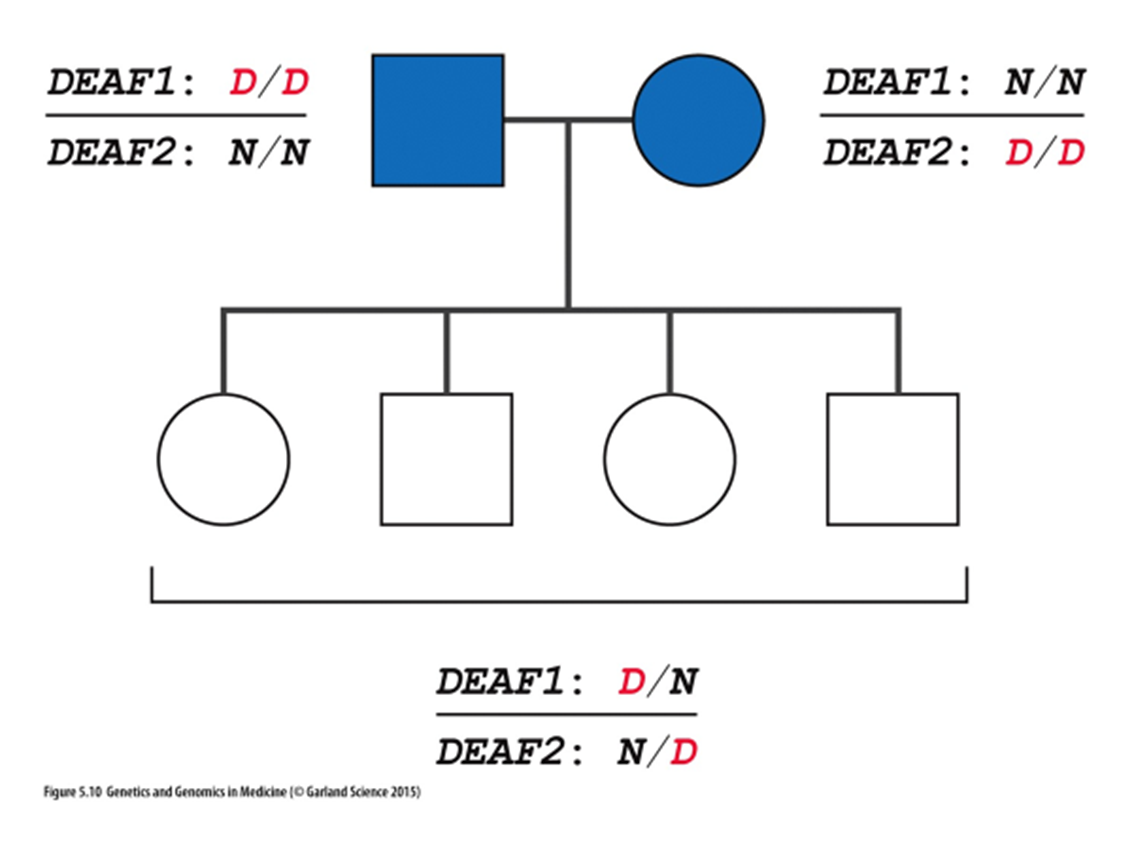
Ch. 5 – Inheritance Patterns, Phenotype Variability, and Allele Frequencies.
What is a gene? What is the proper way to write human gene names? Do you have two alleles for every gene? Why or why not?
Gene: a specific sequence of DNA that encodes a particular protein
Allel: a version of a gene (they exist in the same locus (location) of a chromosome)

Human gene names:
ALL CAPS and in italics
example: CFTR
What does it mean for a trait to be mono-genic or multifactorial? What is Mendelian inheritance?
3 laws of Mendelian inheritance
Law of segregation: Offspring inherit one genetic allele form each parent
The law of Independent Assortment: the inheritance of one trait is not dependent on the inheritance of another
not always the case:
monogenic: only one gene influences the observed characteristic
eye-color 👁️
Multifactorial traits: multiple genes and environmental factors influence observed trait
skin color
Law of Dominance: An organism with alternate forms of a gene will express the form that is dominant
What does it mean for a trait to be mono-genic or multifactorial? What is Mendelian inheritance?
monogenic: only one gene influences the observed characteristic
eye-color 👁️
Multifactorial traits: multiple genes and environmental factors influence observed trait
skin color
Mendelian inheritance → always monogenic
Dominant and recessive phenotypes are not the only phenotypes. What are some other examples?
Incomplete Dominance: the phenotype of a heterozygote is intermediate between the two homozygotes
example:

Co-dominance: both dominant alleles contribute equally to the phenotype
example:
eggplant
ABO blood group system
Epistasis: the expression of one gene modifies the phenotype during the presence of one or more other genes
Be able to read and interpret which of the five basic inheritance patterns a pedigree is depicting.
**Pedigrees (**stammbäume): Graphical representation of a family tree with standardized symbols
Types:
Autosomal dominant
Autosomal recessive
X-linked dominant
X-linked recessive
Y-linked (patrilineal)
Mitochondrial (matrilineal)
Vocabulary :
Proband proposito=male proposita=female family member whom the family is first ascertained: brought to the attention of health care professionals
Kindred Extended family covering many generations
Sib (sibling) brother or sister
Sibship: a series of brothers and sisters

Be able to calculate the frequency with which autosomal dominant and recessive disorders are inherited given the carrier/affected status of parents. How do offspring of consanguineous fair?
What is consanguinity? How is the coefficient of relationship calculated?

Explain how men are constitutionally hemizygous for most genes on the X-chromosome and women are functionally hemizygous. Why most genes and not all genes? True or False?: Males are never heterozygous for Y-linked sequences. Be able to explain.
constitutionally hemizygous → if you only have one X chromosome
functionally hemizygous → in females, due to X-inactivation
FALSE: because men only have one Y chromosome therefore they are hemizygous
What are examples of patrilineal and matrilineal inheritance? What is heteroplasmy?
patrilineal inheritance: passing down traus from the father to son
example: Y-linked traits ability to produce sperm
matrilineal inheritance: passing down the trait from mother to offspring( all sexes)
example: mitochondrial DNA
Heteroplasmy: the presence of more than one type of mitochondrial DNA within an individual cells
due to mutations in mitochondrial DNA during cells division resulting in a mixture of normal and mutated mitochondria DNA

Why is the ascertainment bias high for recessive conditions?
Ascertainment bias: when a particular trait is overrepresented in a pedigree ( normally recessive disease but more than 1/4 of people have the disease)
Disease is more common in family than in population
How can two affected parents (of autosomal recessive disease) produce an unaffected child? What is locus heterogeneity? Allelic heterogeneity? Phenotypic heterogeneity? (see also see p. 556 and glossary)
different locus heterogeneity → the mutations from parents are on a different location on chromosome
Allelic heterogeneity refers to the presence of different mutations within the same gene that can cause the same phenotype
a different mutations of Cystic fibrosis all cause cystic fibrosis
Phenotypic heterogeneity refers to the same genotype results in different phenotype
example muscular dystrophies
What is penetrance? Why do we not always see 100% penetrance?
Penetrance: the likelihood of an individual with a particular genetic mutation developing the condition associated with that mutation
example, allergies
age-related penetrate due to
incremental tissue death
loss of function of the normal protein and toxic accumulation of mutant version( pre-diabetic)
inability to repair some sort of environmental damage
second mutation ( two-hit)
expressivity: the degree of severity or extent of expression
What is the difference between a mosaic organism and a chimera? How could each occur?
mosaic organisms: mutation during embryonic development resulting in some cell having the mutations while others do not
chimera: when a person has at least two distinct genotypes within their body due to a fusion of two embryos during development

What are assumptions made by the Hardy-Weinberg Law?
The law states that under certain conditions, the frequencies of alleles and genotypes in a population will remain constant from generation to generation.
Allele frequencies are not changing
The population size is infinite
Mutations are not occurring
Mating is random
There is no purifying selection
There is no gene flow
Be able to explain how genetic drifts, bottle necks, the founder effect influence allele frequencies.
geneflow: the transferring of genetic diversity among populations resulting in a change on allele frequencies
genetic drift: the random fluctuations of allel frequencies within a population
bottleneck event: an event that causes a severe reduction in population size and the next generation only has the alleles of the small population
founder effect: a type of genetic drift when small group in populations establishes new population and normally less frequent alleles become more common in new population

Why do some genetic mutations remain in the population? Are high mutation rates and unstable genes enough to explain why harmful disease alleles persist? What is balancing selection?
because mutations are not harmful to current environment or press after giving birth to children
tumors
most disease are in ressiev forms → carries
must mutations are neutral
some mutations are advantages to enviriment
malaria and sickle cell anemia
Balancing selection: a type of natural selection which maintains genetic diversity → heterozygous genotype has higher fitness ( due to better adaptation) than homozygous genotypes leading to maintenance of both alles in population
Be able to explain selective sweeps, “hitchhiking alleles” and loss of heterozygosity. (more in 11.4)
selective sweeps: occur when beneficial mutations arise in a population and rapidly increase due to positive selection. While the mutation spreads it sweeps out or eliminates nearby genetic variation
hitchhiking alleles: when an allele changes frequency not because it itself is under natural selection but because it is near another gene that is undergoing a selective sweep and that is on the same DNA chain.
loss of heterozygosity: Heterozygosity refers to the presence of different alleles at a given locus or gene in an individual, and loss of heterozygosity occurs when one allele becomes fixed in the population due to positive selection. This results in a loss of genetic variation at the affected locus or gene.
Ch. 5 – Inheritance Patterns, Phenotype Variability, and Allele Frequencies.
What is a gene? What is the proper way to write human gene names? Do you have two alleles for every gene? Why or why not?
Gene: a specific sequence of DNA that encodes a particular protein
Allel: a version of a gene (they exist in the same locus (location) of a chromosome)

Human gene names:
ALL CAPS and in italics
example: CFTR
What does it mean for a trait to be mono-genic or multifactorial? What is Mendelian inheritance?
3 laws of Mendelian inheritance
Law of segregation: Offspring inherit one genetic allele form each parent
The law of Independent Assortment: the inheritance of one trait is not dependent on the inheritance of another
not always the case:
monogenic: only one gene influences the observed characteristic
eye-color 👁️
Multifactorial traits: multiple genes and environmental factors influence observed trait
skin color
Law of Dominance: An organism with alternate forms of a gene will express the form that is dominant
What does it mean for a trait to be mono-genic or multifactorial? What is Mendelian inheritance?
monogenic: only one gene influences the observed characteristic
eye-color 👁️
Multifactorial traits: multiple genes and environmental factors influence observed trait
skin color
Mendelian inheritance → always monogenic
Dominant and recessive phenotypes are not the only phenotypes. What are some other examples?
Incomplete Dominance: the phenotype of a heterozygote is intermediate between the two homozygotes
example:

Co-dominance: both dominant alleles contribute equally to the phenotype
example:
eggplant
ABO blood group system
Epistasis: the expression of one gene modifies the phenotype during the presence of one or more other genes
Be able to read and interpret which of the five basic inheritance patterns a pedigree is depicting.
**Pedigrees (**stammbäume): Graphical representation of a family tree with standardized symbols
Types:
Autosomal dominant
Autosomal recessive
X-linked dominant
X-linked recessive
Y-linked (patrilineal)
Mitochondrial (matrilineal)
Vocabulary :
Proband proposito=male proposita=female family member whom the family is first ascertained: brought to the attention of health care professionals
Kindred Extended family covering many generations
Sib (sibling) brother or sister
Sibship: a series of brothers and sisters

Be able to calculate the frequency with which autosomal dominant and recessive disorders are inherited given the carrier/affected status of parents. How do offspring of consanguineous fair?
What is consanguinity? How is the coefficient of relationship calculated?

Explain how men are constitutionally hemizygous for most genes on the X-chromosome and women are functionally hemizygous. Why most genes and not all genes? True or False?: Males are never heterozygous for Y-linked sequences. Be able to explain.
constitutionally hemizygous → if you only have one X chromosome
functionally hemizygous → in females, due to X-inactivation
FALSE: because men only have one Y chromosome therefore they are hemizygous
What are examples of patrilineal and matrilineal inheritance? What is heteroplasmy?
patrilineal inheritance: passing down traus from the father to son
example: Y-linked traits ability to produce sperm
matrilineal inheritance: passing down the trait from mother to offspring( all sexes)
example: mitochondrial DNA
Heteroplasmy: the presence of more than one type of mitochondrial DNA within an individual cells
due to mutations in mitochondrial DNA during cells division resulting in a mixture of normal and mutated mitochondria DNA

Why is the ascertainment bias high for recessive conditions?
Ascertainment bias: when a particular trait is overrepresented in a pedigree ( normally recessive disease but more than 1/4 of people have the disease)
Disease is more common in family than in population
How can two affected parents (of autosomal recessive disease) produce an unaffected child? What is locus heterogeneity? Allelic heterogeneity? Phenotypic heterogeneity? (see also see p. 556 and glossary)
different locus heterogeneity → the mutations from parents are on a different location on chromosome
Allelic heterogeneity refers to the presence of different mutations within the same gene that can cause the same phenotype
a different mutations of Cystic fibrosis all cause cystic fibrosis
Phenotypic heterogeneity refers to the same genotype results in different phenotype
example muscular dystrophies
What is penetrance? Why do we not always see 100% penetrance?
Penetrance: the likelihood of an individual with a particular genetic mutation developing the condition associated with that mutation
example, allergies
age-related penetrate due to
incremental tissue death
loss of function of the normal protein and toxic accumulation of mutant version( pre-diabetic)
inability to repair some sort of environmental damage
second mutation ( two-hit)
expressivity: the degree of severity or extent of expression
What is the difference between a mosaic organism and a chimera? How could each occur?
mosaic organisms: mutation during embryonic development resulting in some cell having the mutations while others do not
chimera: when a person has at least two distinct genotypes within their body due to a fusion of two embryos during development

What are assumptions made by the Hardy-Weinberg Law?
The law states that under certain conditions, the frequencies of alleles and genotypes in a population will remain constant from generation to generation.
Allele frequencies are not changing
The population size is infinite
Mutations are not occurring
Mating is random
There is no purifying selection
There is no gene flow
Be able to explain how genetic drifts, bottle necks, the founder effect influence allele frequencies.
geneflow: the transferring of genetic diversity among populations resulting in a change on allele frequencies
genetic drift: the random fluctuations of allel frequencies within a population
bottleneck event: an event that causes a severe reduction in population size and the next generation only has the alleles of the small population
founder effect: a type of genetic drift when small group in populations establishes new population and normally less frequent alleles become more common in new population

Why do some genetic mutations remain in the population? Are high mutation rates and unstable genes enough to explain why harmful disease alleles persist? What is balancing selection?
because mutations are not harmful to current environment or press after giving birth to children
tumors
most disease are in ressiev forms → carries
must mutations are neutral
some mutations are advantages to enviriment
malaria and sickle cell anemia
Balancing selection: a type of natural selection which maintains genetic diversity → heterozygous genotype has higher fitness ( due to better adaptation) than homozygous genotypes leading to maintenance of both alles in population
Be able to explain selective sweeps, “hitchhiking alleles” and loss of heterozygosity. (more in 11.4)
selective sweeps: occur when beneficial mutations arise in a population and rapidly increase due to positive selection. While the mutation spreads it sweeps out or eliminates nearby genetic variation
hitchhiking alleles: when an allele changes frequency not because it itself is under natural selection but because it is near another gene that is undergoing a selective sweep and that is on the same DNA chain.
loss of heterozygosity: Heterozygosity refers to the presence of different alleles at a given locus or gene in an individual, and loss of heterozygosity occurs when one allele becomes fixed in the population due to positive selection. This results in a loss of genetic variation at the affected locus or gene.
 Knowt
Knowt



